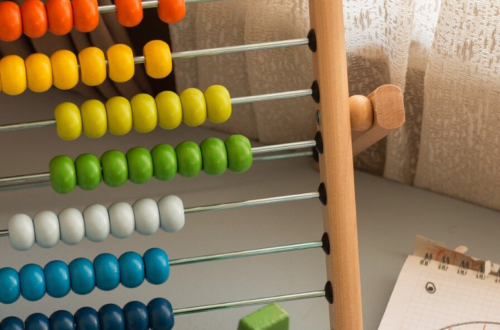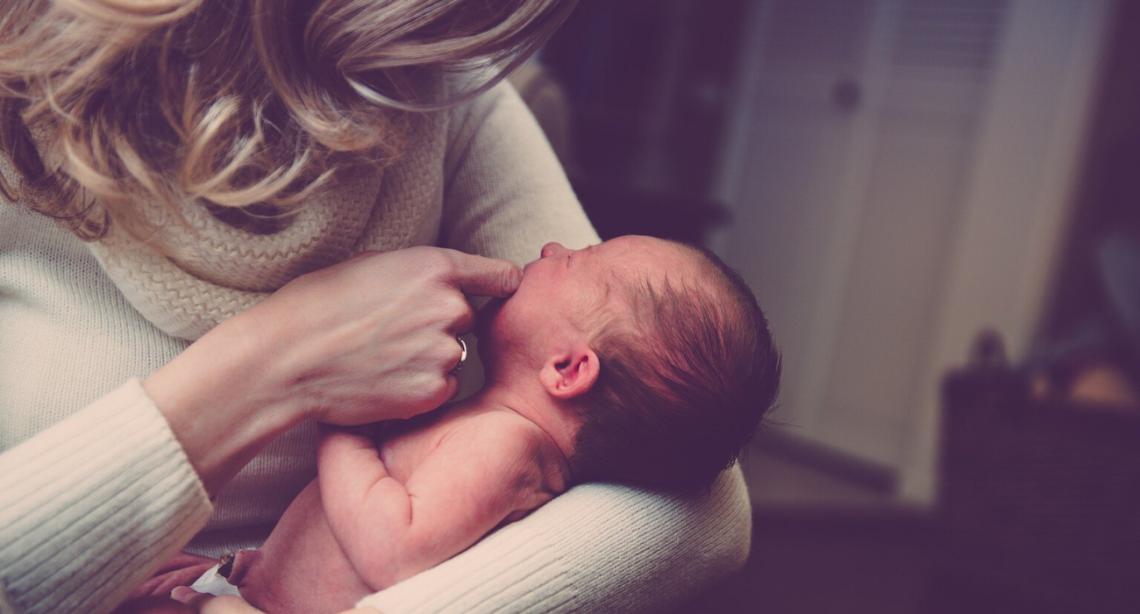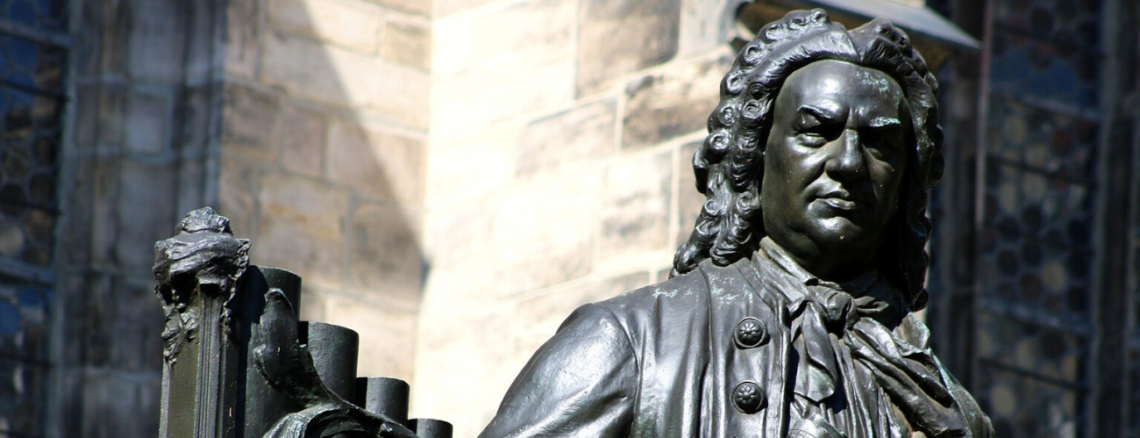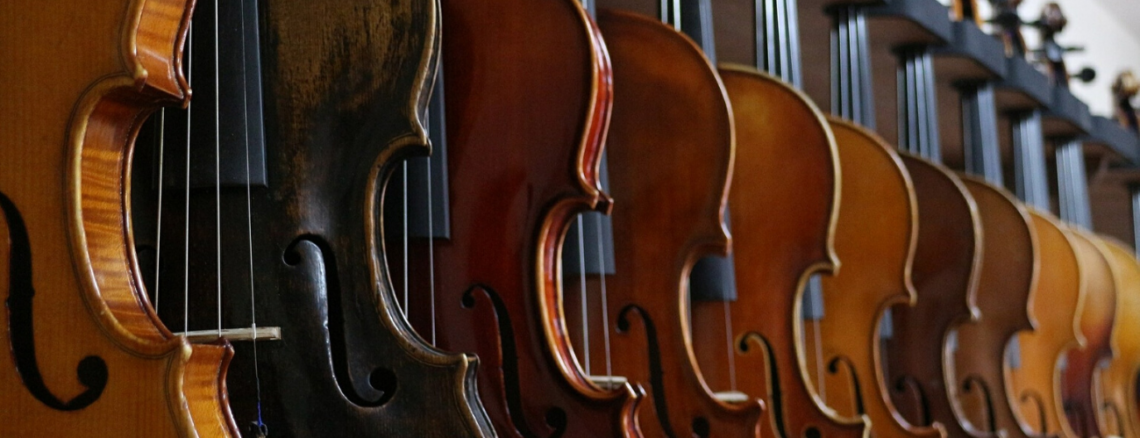-
Performing with Palestrina, or Classical Music for Babies and Toddlers

Today my son, Little M, and I want to take you back a little bit before the Baroque period to explore some music from the Renaissance!
Little M is currently a one-year-old, so he’s a baby that’s just about to become a fast and furious toddler! Even though he’s all over the place and into everything right now, he’ll still slow down to listen to this music. He loves watching singers, especially, and he literally crawl-runs over to the computer when he hears the beginning of a piece of classical music!
The Renaissance period of classical music lasted from approximately 1400–1600. It came right before the Baroque period, which was roughly from 1600–1750.
I always say that the Baroque period–and other historical periods–are “roughly” or “approximately” from blah to blah because there was always stylistic overlap between eras. The world didn’t just wake up on January 1st of the year 1600 and find themselves in the Baroque period, for example! It was a much more gradual shift.
Also, if you want to learn more about Baroque music, check out our post called “What is Baroque Music?”.
A cappella vocal music–which is music for singers without any instruments–reached its peak during the Renaissance. The composer of today’s selection, Giovanni Pierluigi da Palestrina (c1526–1594), was one the very best composers in this genre. His music is looked at today as sort of the “gold standard” of what’s called Renaissance polyphony, which is vocal music for many voices singing together (“poly” means “many” in Latin).
Before we get to the music, here’s a short bio on Palestrina to get you up to speed.

Palestrina’s Bio
Giovanni Pierluigi da Palestrina (c1526–1594) was probably born in Palestrina, Italy, but we’re not sure exactly when. The “da Palestrina” part of his name literally translates to “from Palestrina.”
The town of Palestrina is near Rome, so it is no surprise that Palestrina the musician and composer ended up in Rome by his teenage years. He went back to the town of Palestrina for a while, but spent most of his life living and working in Rome.
Palestrina worked for a while as an organist in his hometown. But then his position was majorly upgraded and he starting working for Pope Julius III in St. Peter’s Basilica in Rome. He worked as the musical director at various other churches in Rome, and these positions included composing a lot of vocal music.
Near the end of his life he finally had enough money to focus even more on composing music. He continuing working at churches in Rome, however, until his death in 1594. He is buried in St. Peter’s Basilica, though it’s unclear now exactly where. (St. Peter’s is gigantic–it is literally the largest church in the world!)

The Music
Palestrina’s “Quando dal terzo cielo” for six voices is the music Little M and I want to share with you today.
In the video, all six parts are sung by men, which is how it would have been performed originally. Polyphonic vocal music (What’s that? See above.) of the Renaissance usually didn’t include women singers because much of the music was intended for the church (although this piece was not) and women weren’t allowed to sing in church at that time.
Instead, some of the men would sing in the high, female vocal range. Today we call these men countertenors, and you’ll hear and see two of them in this piece. The other four singers are tenors, baritones, and basses, which sing in the ranges we more commonly associate with the male voice.
The title of this piece–“Quando dal terzo cielo”–means “When from the third heaven” it Italian, and it is about the myological diety Dori. The song praises Dori’s great beauty and delightful attitude.
Despite only talking about Dori, the song was actually a way to flatter the wife of the man who paid to have the piece written. It would have been considered rude to name the man’s wife directly, so this was one way to get around that!
We hope you enjoy the music! Let us know what you think by leaving us a comment below!
This performance is by the King’s Singers. Check them out on their website or their YouTube channel!
If you want to check out the whole CD, you can find it on Amazon by clicking the image below. (Disclaimer: We may receive compensation [at no extra cost to you!] when you click on the links to this CD.)
-
10 Essential Newborn Items You May Have Forgotten
This post contains affiliate links. We may receive compensation (at no extra cost to you!) when you click on these links.

In addition to being a musician and blogger, I’m also a relatively new mom–my son, Little M, is a one-year-old. And so I wanted to share with you all some of the newborn items I consider completely essential, especially ones you may have forgotten to add to your baby registry. These are all items I use or have used every day that I absolutely couldn’t live without as a new mom.
1. Skip Hop Pronto Signature Portable Changing Station
Forget the diaper bag and get this Skip Hop portable changing station instead. It’s incredibly easy to carry around and you can clip it to your stroller or pack it in a suitcase or bag. You can even clip it around your wrist if you’re carrying your baby to a diaper change location.
This changing station helps protect your baby and keep him or her comfortable on public changing tables because it folds out into a cushioned changing mat! It also holds quite a lot of diaper-changing supplies: wipes, tissues, a few small bottles (like a small diaper cream and anti-bac), a change of clothes, and about eight diapers. The inside and outside can both be easily wiped down with disinfecting wipes for further germ reduction.
Best of all, this portable changing station means one less bag to carry around and keep track of. This is especially important if you’re flying anywhere. It means fewer items to carry around and can even save you the money of paying for an extra bag just by popping it in your suitcase!
While it is super portable, you should know that it’s not super tiny. When it’s stuffed full with wipes and diapers (it holds about eight diapers) it can be rather thick. It would still fit in a backpack that’s not too full and most any suitcase, however.
2. My Brest Friend Nursing Pillow
If you’re planning to breastfeed, this item is an absolute must. Being a mom on a budget, I thought I could just use pillows and cushions to support my baby while breastfeeding. But I was so totally wrong and ordered the My Brest Friend Nursing Pillow on Amazon within a few days of my son’s birth! Learn from my mistake!
A bunch of moms totally love the Boppy Nursing Pillow. I’ve tried both the Boppy and the My Brest Friend and I personally believe that the My Brest Friend Nursing Pillow is 10 times better!
In my opinion, the My Brest Friend offers much better support for your baby. It also has back support for mom. It clips around your waist so that it’s easy to move around while it’s on (though don’t walk around while nursing your baby on it!). Another plus is that it comes with a handy snack pocket for those times when you might not want to move your snoozing baby but really need something to eat.
There are only two cons: the pillow itself isn’t washable (though the cover is) and it might be a tight fit for heavier mothers. I solve the non-washable issue by placing a hand towel on top of the cover for extra protection. This puts an extra layer of (absorbent) material between my baby and the pillow. The poor fit issue was one I had right after giving birth, but after losing some of my pregnancy water weight gain during the first week postpartum I’ve had no problems even though I’m still over 200 lbs.
With the sheer number of hours you’re going to spend nursing or bottle-feeding your baby you want something that’s comfortable for both of you. The My Brest Friend Nursing Pillow is definitely that item! It’s also durable enough that you won’t have to replace it.
3. An extra cover for your nursing pillow
Whether you have the My Brest Friend or the Bobby, definitely buy a second (or even a third) pillow cover. (Here’s a link for the My Brest Friend. And here’s one for the Bobby.)
Babies spit-up. A lot. And have diaper blowouts. You get the picture. You definitely don’t want to be stuck with a hungry baby and no clean nursing pillow cover!
If you want, you can get a waterproof cover. But as I mentioned above, I just place a hand towel over my nursing pillow cover and didn’t spend the extra money on a waterproof one.
4. Kindred Bravely Organic Reusable Nursing Pads
These washable nursing pads by Kindred Bravely are a breastfeeding momma’s dream come true! They’re organic–so no questionable chemicals against your skin!–soft, and hold a lot of milk spillage, which you’re likely to have early on, especially at night.
They also come with a beautiful storage bag that doubles as a wet bag for when you’re out and about and need to change them. They’re machine washable (yay!). They are also healthier for you than disposable nursing pads since they’re made of a breathable material, which helps prevent infections.
I love these Kindred Bravely nursing pads and I ended up buying two sets (since they’re not that expensive!) after deciding I wanted to do laundry less frequently.
5. Milk Bands Breastfeeding Reminder
One more breastfeeding item and then on to other topics. This Milk Band is something else I absolutely couldn’t live without, however, and I had no idea I would need it until I started breastfeeding.
In the early days you’re going to be feeding your baby all the time (and I mean ALL. THE. TIME.) and if you’re breastfeeding this is going to be a lifesaver. It helps to remind you what breast you started your last feed on. This may not sound like a big deal but it’s super important for helping to avoid painful plugged ducts and dangerous mastitis.
If you’re breastfeeding, you’ll be making a lot of milk in the first few months since your baby will be nursing a lot. In order for your breasts to stay healthy you need to empty out their milk consistently. The best way to do this is to start each feed on the opposite side from the last feed. This is where the Milk Band comes in.
The Milk Band is super simple to use. You wear it as a bracelet (on either wrist) and one side says “LEFT” while the other says “RIGHT.” You can use it however works best for you, but I turn it over at the beginning of a feed to show which side that session was started on.
It also comes with small plastic trackers to measure how many hours each day you’ve nursed so far. Those tend to break, however, and I didn’t need them (and you don’t need them to use the band), so I just took them off right away and have always used mine without them.
The Milk Band comes in a bunch of different colors–each color has a separate listing on Amazon–so pick your favorite and consider it your new piece of stylish mamma jewelry!
6. Large 6-Quart Crock-Pot
Okay, this one’s kind of weird, but I promise you’ll thank me later! If you don’t have a slow cooker, or even if you do but don’t have a big one, you should totally buy this 6-Quart Crock-Pot.
As a new mom it’s hard to find the time to cook–finding even an extra 15 minutes in the day can sometimes be difficult. It’s also difficult to always know when you’re going to have free time, so getting a meal off the stove or out of the oven before it burns can sometimes be a challenge.
This is why a Crock-Pot is an essential item. For many meals you can just dump all your ingredients into the slow cooker (can you say “15-minute total prep time”?!) and then just set it and forget it.
You can easily find recipes that take 8, 4, or 2 hours (depending on whether you use the “low” or “high” temperature setting). And if you can’t get your food right when it’s supposed to be done–because your baby’s crying or you’re taking a shower (or you simply forgot about it in your exhausted state)–it’s no big deal! As long as you get to it within the next 30-60 minutes your food should still be fine!
I love this 6-Quart Crock-Pot because it’s big enough that my husband or I can cook two meals at a time. We’re able to feed all three members of our family for both a dinner and the next day’s lunch with only cooking once, saving even more money and time.
7. NorthShore Disposable Changing Pads and Summer Infant Waterproof Changing Pad Liners
You probably have a changing pad a cover on your registry, but I highly recommend getting both these items as well. I’ll never change another diaper again without both of these liners used together unless I absolutely have to!
It’s great if you have your changing station set up with a waterproof changing pad and a good-looking pad cover (or you can just use a receiving blanket like we do). But one of the first things your baby is going to do to that perfect setup is pee and poop and possibly even spit up all over it! Those are all the things newborn babies are great at!
I’m all about doing laundry as infrequently as possible, however. So my changing station is set up with a Summer Infant Waterproof Changing Pad Liner on top of the changing pad cover (or receiving blanket) and a NorthShore Disposable Changing Pad on top of that.
Ninety percent of the time messes only affect the disposable changing pad (which is also waterproof) and I can throw it out. Sometimes, though, the mess is more intense and gets on the changing pad liners, but those are completely machine washable and can even go in the dryer. Almost always the cover on the changing pad stays clean and the changing pad itself very rarely needs wiping down.
If you only get one of these items I’d definitely recommend the disposable changing pads, but I think both work very well together.
8. Fisher-Price Infant-to-Toddler Rocker
A chair like this is probably not on most baby registries, but I found it to be absolutely indispensable. Whenever I was on our couch–and it felt like I *LIVED* on our couch for the first few months with all the breastfeeding and baby naps–it was essential to have someplace safe to set down my baby when I needed a break or needed to go get something.
The Fisher-Price Infant-to-Toddler Rocker has a wide, stable base and a three-point harness for keeping babies safe who can’t yet sit up on their own (which usually happens around 5-7 months old). It was life-changing to be able to set my newborn down right next to me for a few moments instead of having to constantly hold him or take him to another room to put him down somewhere safe. It also has a “calming” mode where the chair vibrates, but we haven’t used that much.
Now that my son can sit up on his own we’ve put the chair away because he can tip it over. The beauty of the Fisher-Price Infant-to-Toddler Rocker, however, is that once he’s a little older we can get it out again and he can use it as a toddler.
I love this chair so much (and its pretty cheap price tag!) that I bought two more–one for each set of grandparents–in addition to the one we have a home!
9. BAURAS Shatterproof Backseat Car Mirror
I’m sure your baby registry has a car seat, but you may have forgotten your backseat baby mirror.
I’m always am checking in on my baby when we’re in the car and the only safe way for me to do that when I’m driving is by having a backseat baby car mirror. I love the Backseat Car Mirror by BAURAS because it’s large, stays put most of the time (it only needs occasional readjusting every few months), and, most importantly, it’s shatterproof so I know it won’t break if we get in an accident.
You’ll need to have a vehicle with headrests in the backseat, though anywhere in the backseat is fine since you can swivel the mirror quite far left and right. Your baby or child will also need to still be in a rear-facing car seat (which they should be until at least age 2 anyway) in order to see them in the mirror.
10. HALO SleepSack
This item is pretty popular so you may already have it on your baby registry. Our baby doesn’t sleep a single night without it, however, and I think the HALO brand makes absolutely the best version of the sleepsack, so I’ve decided to include it here.
Baby sleep safety is essential in helping to prevent SIDS. The HALO SleepSack is a sleeveless wearable blanket. It helps your baby stay as safe as possible while sleeping by keeping your little one warm and cozy without the suffocation hazards of a regular blanket. The fact that it’s sleeveless also helps keep your baby from overheating.
The HALO SleepSack has a lot of extra features for comfort and convenience. The newborn version comes with a swaddle option to reduce nighttime wakings caused by the startle reflex. It also zips up from the bottom to make diaper changes easier and keep the zipper out of baby’s face.
It comes in five sizes–preemie through extra large–and the swaddle option is offered on preemie, newborn, and small. Footless versions are also offered for older children.
The cotton version is the most standard and lightest-weight one, but it also comes in micro-fleece and plush for those cold winter nights. There is even a heavy, quilted version (starting at size small) in case you live somewhere with very cold winters (though be careful not to dress your baby too warmly at night because that’s also a SIDS hazard).
Our baby has used these in all seasons and sizes. He has at least one cotton and one plush in every size and other types in other sizes based on the time of year he was a certain height and weight. I totally love this brand and I sleep well at night knowing that he’s as safe as possible in his HALO SleepSack!

In Conclusion: Check Out the Rest of Our Blog–It’s About Music for Babies and Kids!
Baby product recommendations are not the main focus of Baby Loves Baroque–we’re actually all about exploring classical music with your kids! So go check out the rest of our blog–you might be surprised by what you find!
-
Vivaldi and Violins, or Baroque Music for Babies

In today’s exploration of Baroque music that’s great for babies and children, my son, Little M, and I would like to share a piece with you by Antonio Vivaldi (1678–1741). You might already know about Vivaldi and his most famous work, a set of violin concertos called “The Four Seasons,” or Le quattro stagioni.
Vivaldi wrote more than 500 hundred concertos–pieces for a solo instrument, or group of soloists, and orchestra–and nearly half of those are for violin. But that’s not all that he’s known for. Here’s a short Vivaldi bio to give you some more info.
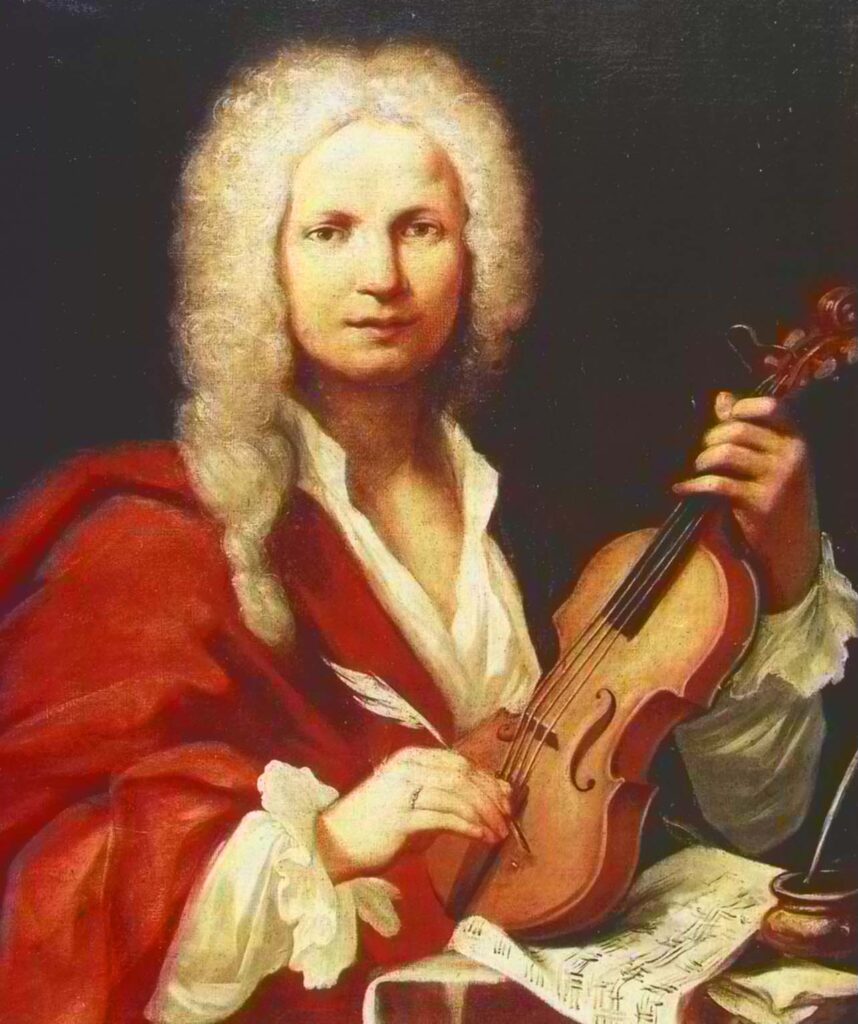
Vivaldi’s Bio
Vivaldi was known as “The Red Preist” because he had red hair and was. . . you guessed it. . . a Catholic priest. He was an Italian composer, born in Venice, Italy, in 1678, and he spent most of his life working at an orphanage there: the Ospedale della Pietà.
At the Ospedale he was in charge of an all-female musical ensemble, which consisted of an orchestra and choir. His ensemble and the ensembles of the other orphanages in Venice were considered to be very good, so good, in fact, that travelers from all over Europe came to hear them.
Vivaldi wrote most of his music for this ensemble, including more than 60 vocal works such as his Gloria in addition to his 500+ concertos. But he also wrote nearly 50 operas and some other works for musicians outside of the Ospedale.
After his death in 1741, his works were mostly forgotten until they were “rediscovered” in the 1920s and 30s and started to be programmed again on concerts.

The Music
The piece we want to share with you is from Vivaldi’s L’estro armonico (1711), which is an important published collection of concertos for one, two, and four violins with string orchestra. This piece is the third movement of the eighth concerto in that collection.
A movement is a [usually] short piece that is grouped together with other pieces to form a larger, complete piece.
It’s fast and furious, but also has tender moments that show the expressivity of the violins. Baroque music with these qualities is good for babies and children because it can hold their attention while also furthering their emotional development.
If you want to know more about any of the instruments you’re seeing, check out our Guide to Baroque Instruments. The instruments in this video are called “period instruments” because they were made at the same time period (i.e. hundreds of years ago!) as the music being played, or they are exact copies of instruments from that time period.
We hope you enjoy the music! Let us know what you think by leaving a comment below!
This performance is by the Irish Baroque Orchestra. Go check them out on their website or their YouTube channel!
-
Beginning with Bach, or Bach for Babies

There’s no better place to begin learning about Baroque music than with Johann Sebastian Bach (1685–1750)–he’s a famous classical music composer who is great for babies, children, and pretty much everyone else! Even though my one-year-old son, Little M, is just a baby, he loves Bach! And Bach is such a big deal that you’ve probably already heard of him, even if you’ve never listened to classical music before.
Spoiler Alert: You’ve actually already heard a lot of classical music in your life, even if you don’t know it! It’s in commercials and movies, in shopping malls and sometimes even elevators. You’ve almost definitely heard a lot more classical music than you think you have!
But who was Bach? And how did he become so famous? Here’s a short Bach bio to fill you in.
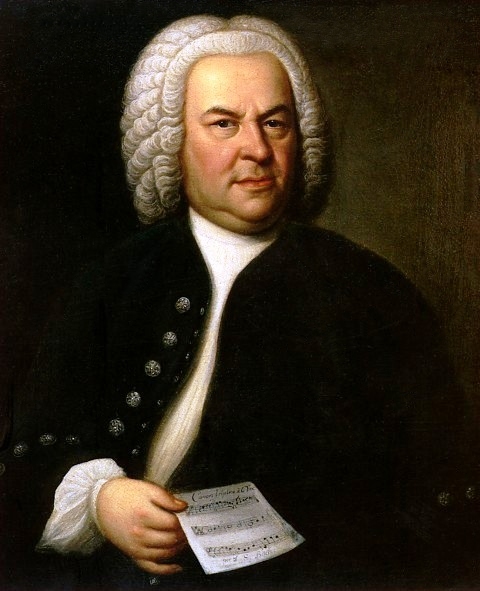
Bach’s Bio
J.S. Bach was born in Eisenach, Germany, in 1685. He started studying music at a very young age and even though both of his parents died by the time he was 10 years old, one of his brothers took care of him and helped him continue studying music.
As Bach grew up, he moved around to a few different cities in Germany, working as a musician everywhere he went. In 1723 he ended up in Leipzig, working as the music director for several churches there and teaching in the St. Thomas boys’ school. The move to Leipzig was the last one he made: he lived and worked there until his death in 1750.
Bach wrote more than 1,000 pieces that still survive today (and probably many more that no longer exist). He wrote both instrumental music–or music for instruments without voices–and vocal music–or music that includes singing.
Though he wasn’t super well-known during his lifetime, in the early 1800s–nearly 100 years later!–another composer, Felix Mendelssohn (1809–1847) thought his music was pretty amazing. Mendelssohn wanted more people to know about Bach’s music, so he put on a big Bach concert and that was the beginning of Bach’s fame. After that everyone saw just how great Bach’s music was and the rest is history.

The Music
So the piece of music my one-year-old son, Little M, and I want to share with you today is the first movement of one of Bach’s cantatas, “Wir danken dir…” (BWV 29).
A movement is a short(ish) piece that is grouped with other movements to form a larger musical piece. A cantata, in this context, is a piece of music for voices and instruments.
Even though this is a cantata (so it has singers), the first movement is just instruments, so you don’t need to worry about understanding any text.
This movement is fun and flashy and really enjoyable to watch as well as listen to! This is one of the reasons that Bach is great for babies–his music is often good at capturing their attention, especially with great performance videos!
If you want to know more about any of the instruments you see in the video, check out our Guide to Baroque Instruments. The instruments in this video are called “period instruments” because they were made in the same time period (i.e. hundreds of years ago!) as the music being played, or they are exact copies of instruments from that time period.
We hope you enjoy the music! The first movement ends at about 3:50, so you can stop the video there or keep listening if you want to hear more. Let us know what you think by leaving us a comment below!
This performance is by the Netherlands Bach Society. Go check them out on their website or their YouTube channel!
-
5 Reasons Why Your Children Should Listen to Classical Music

While experts are divided on whether or not listening to classical music actually makes babies and children smarter, here are five reasons why your kids (and you) should be listening to it anyway.
1. It’s exciting!
Articles about the childhood benefits of classical music often emphasize its soothing qualities, but that’s just one small part of what classical music is. Classical music can be anything you want it to be if you know where to look, from joyful to heartbreaking to calming and even inspiring. In fact, one of the main goals of classical music has always been to express and evoke intense emotions! This can help to further a child’s emotional development.
2. It’s social.
Even if you’re stuck at home, watching or listening to classical music can be a group activity. You and your kids can watch performances and talk about what you see and hear. You can have a dance party in your living room to some classical music with a great beat! Or you could even put on classical music in the background while you play with your baby or do some other activities with your kids. There are endless possibilities for interaction involving classical music.
3. It’s educational.
Classical music brings a lot to the table in terms of education. You and your kids could learn about instruments and the different sounds they make. Or maybe you are more interested in history: there are hundreds of years of sounds and stories to discover. Exploring classical music might even inspire your child to learn an instrument, which comes with endless developmental benefits including enhanced memory, better coordination, and stronger complex reasoning skills.
4. It’s something new.
New experiences help babies and children (and everyone else) learn about the world around them. This furthers their cognitive and emotional development and makes their lives richer, even from an early age. And even if you’ve listened to some classical music in the past, you can never run out of new pieces and styles. There are endless exciting classical music experiences awaiting you!
5. It’s budget-friendly.
While live concerts are the ideal way to experience classical music and support classical musicians, it is easy to begin exploring and enjoying classical music from your own home. Hundreds of thousands of hours worth of pre-recorded performances and albums can be found on YouTube, and even more-obscure composers and pieces are often on Spotify, iTunes, or other online music services. High-definition performance recordings can also be visually captivating so finding the perfect piece to turn a bored child into an occupied one is often just a (free) click away!
Classical music has so much to offer on so many different levels. I enjoy classical music (as a performer and a listener) because I find it both engaging and enriching: it makes my life happier and more interesting. I also like sharing classical music with my one-year-old for these same reasons. He has a great time listening and learning!

Here are three musical works from my specialty, Baroque music (What’s “Baroque music”? Find out here.), to get you started.
1. “Dopo lungo penare” by Luigi Rossi
Find out more about Luigi Rossi and this piece here.
2. Concerto for Two Violins in a minor, Op.3, No.8, RV 522: III. Allegro by Antonio Vivaldi
Find out more about Antonio Vivaldi and this piece here.
3. Cantata “Wir danken dir…”, BWV 29: First Movement by Johann Sebastian Bach
The first movement ends at about 3:50, so you can stop the video there or keep listening if you want to hear more!
Find out more about Johann Sebastian Bach and this piece here.
If you want to learn more about the instruments you see in these videos, check out our Guide to Baroque Instruments.




